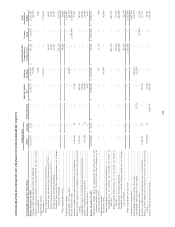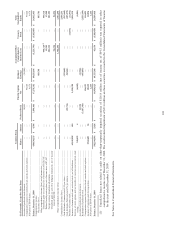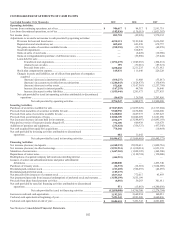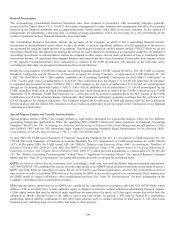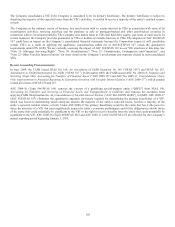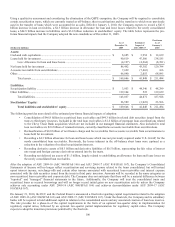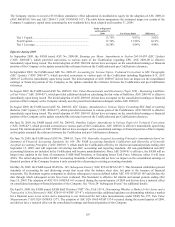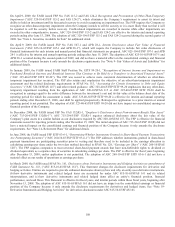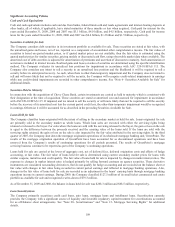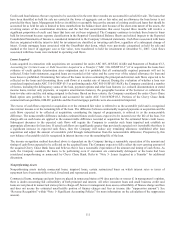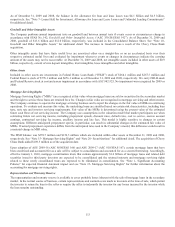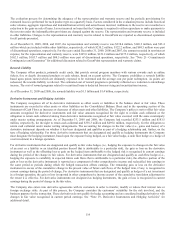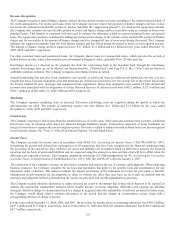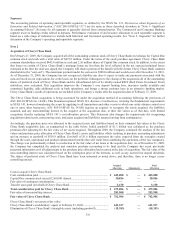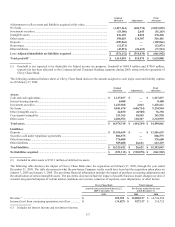Capital One 2009 Annual Report Download - page 123
Download and view the complete annual report
Please find page 123 of the 2009 Capital One annual report below. You can navigate through the pages in the report by either clicking on the pages listed below, or by using the keyword search tool below to find specific information within the annual report. 110
Loan securitization involves the transfer of a pool of loan receivables to a trust or other special purpose entity. The trust sells an
undivided interest in the pool of loan receivables to third-party investors through the issuance of asset backed securities or mortgage
backed securities and distributes the proceeds to the Company as consideration for the loans transferred. The Company removes loans
from the reported financial statements for securitizations that qualify as sales. Alternatively, when the transfer would not be
considered a sale but rather a financing, the assets will remain on the Company’s reported financial statements with an offsetting
liability recognized in the amount of proceeds received by the Company.
The Company uses QSPEs to conduct off-balance sheet securitization activities and SPEs that are considered VIEs to conduct other
securitization activities. See “Note 20 – Securitizations” and “Note 15- Mortgage Servicing Rights” for information regarding our
continuing involvement as transferor of assets to QSPEs and VIEs.
Interests in the securitized and sold loans may be retained in the form of subordinated interest-only strips, servicing right, senior
tranches, subordinated tranches, cash collateral and spread accounts. The Company may also retain a seller’s interest in the receivables
transferred to the trusts which is carried on a historical cost basis and classified as loans held for investment on the Reported
Consolidated Balance Sheet.
The gain on sale recorded from off-balance sheet securitizations is recorded based on the estimated fair value of the assets sold and
retained and liabilities incurred, and is recorded at the time of sale, net of transaction costs. The related receivable is the interest-only
strip, which is based on the present value of the estimated future cash flows from excess finance charges and past-due fees over the
sum of the return paid to security holders, estimated contractual servicing fees and credit losses. The interest-only strip, servicing
assets, cash collateral and subordinated tranches are subject to substantial credit, repayment and interest rate risks on transferred assets
if the off-balance sheet loans are not paid when due. As such, the interest-only strip and subordinated retained interests are classified
as trading assets with changes in the estimated fair value are recorded in servicing and securitization income. Additionally, the
Company may also retain senior tranches in the securitization transactions which are considered to be higher investment grade
securities and subject to lower risk of loss. The retained senior tranches are classified as available for sale securities with changes in
the estimated fair value are recorded in other comprehensive income.
Gains on securitization transactions and fair value adjustments related to residual interests in non mortgage securitizations are
recognized in servicing and securitizations income and amounts due from the trusts are included in accounts receivable from
securitizations. Gains and fair value adjustments on mortgage securitizations are recorded in mortgage servicing and other income. As
of December 31, 2009 and 2008, accounts receivable from securitization totaled $7.6 billion and $6.3 billion, respectively. These
balances consisted of retained residual interests that are recorded at estimated fair value and totaled $4.0 billion and $2.3 billion at
December 31, 2009 and 2008, respectively. The remaining balance relates to cash collections held at financial institutions that are
expected to be returned to the Company on future distribution dates, and principal collections accumulated for expected maturities of
securitization transactions with the subsequent return of loan receivables.
The Company does not typically recognize servicing assets or servicing liabilities for servicing rights retained from credit card, auto
loan and installment loan securitizations since the servicing fee approximates adequate compensation to the Company for performing
the servicing. However, the Company does record an asset for servicing rights related to our mortgage securitizations. See “Note 15-
Mortgage Servicing Rights” for more information about accounting for mortgage servicing rights.
As described above, the Company accounted for loan securitization transactions as sales and accordingly, the transferred loans were
removed from the consolidated financial statements as of and for the years ending December 31, 2009, 2008 and 2007. However,
beginning January 1, 2010, the Company will consolidate certain securitization trusts pursuant to ASU 2009-17 and the securitization
of loan receivables related to these newly consolidated trusts will be accounted for as a secured borrowing rather than as a sale. The
retained interests in securitized assets will be eliminated or reclassified, generally as loan receivables, accrued interest receivable or
restricted cash, as appropriate. See “Note 1- Significant Accounting Policies” for expected financial statement impact and see “Note
20- Securitizations” and “Note 15- Mortgage Servicing Rights” for further information about the accounting for securitized loans.
Loans Held for Investment
Loans are classified as held for investment where management has the intent and ability to hold them for the foreseeable future or until
maturity or payoff. Loans held for investment include consumer and commercial loans. Consumer loans include credit card,
installment, auto and mortgage loans. In determining the amount of loans held for investment, management makes judgments about
the Company’s ability to fund these loans through means other than securitization, such as investments, deposits and other
borrowings. Management assesses whether loans can continue to be held for investment on a quarterly basis by considering capital
levels and scheduled maturities of funding instruments used. Credit card loans are reported at their principal amounts outstanding and
include uncollected billed interest and fees. Loans acquired with the acquisition of Chevy Chase Bank, are accounted for under ASC
310/SOP 03-3. Loans and debt securities acquired with deteriorated credit quality are recorded at fair value without the carry over of
existing valuation allowances. Refer to “Note 2- Acquisition of Chevy Chase Bank” for additional discussion. All other loans are
stated at principal amount outstanding, net of unearned income, unamortized deferred fees and costs, on originated loans.


